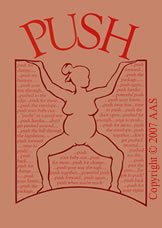I was asked for my perspective on colic and diet on a group list and another article rolled out.
I am certain that diet, particularly the Ayurvedic diet, has a lot to do with supporting conditions that prevent or heal colic. I, of course, have a baby's communication and birth trauma perspective. I have a long article about my perspective on my website:
http://www.itsthebabysbirth.com/parentsknow/colic.htm
I see "colic" as one of those "trash-can" labels or worse a "set-up" in the socio-political-medical community for a lifetime of medical interventions and drug therapies. Starting at the beginning of life, here's why I believe the “diagnosis” of “colic” is the forerunner of ADHD, depression, anxiety, OCD, bipolar, relationship issues, behavior disorders, and the high incidence of childhood and adult gastro-intestinal issues:
Babies need to share their perspective and experience of birth as they are coming into their body -- which is the spiritual-physical task and experience of the newborn for first two to 3 months. The soul is COMING into this body – integrating body-mind-soul. The baby is integrating all that has gone on thus far, including birth.
Mother has her perspective of the labor and birth, father has his, medical caregiver(s), family, friends, and doulas have THEIR own perspective of the birth based on their own experience (of the birth, through the lens of their own, and through their own beliefs and based on their own history). Their story is just their perception of what happened. So, everyone in attendance has their perception of their experience -- no one is wrong. They are just different perspectives.
Now, consider this, would you?
WHOSE BIRTH IS IT? Who is it that made the journey from the womb to the world -- in the presence of others and the environment and energy field (YES! It's "scientific"- quantum physics, in fact.) that THEY create? Whose entire body of organ systems gets to do this amazing transition from being totally dependent on the mother/placenta/umbilical cord to being an INDIVIDUAL, separate, totally, physically independent being -- in a few minutes. AND, who will still be absolutely totally dependent on that single, consistent, loving heart beat that clicked away through development? (And, doctors and woman whose fight is REALLY about the psuedo-feminist battle to work, earn equal pay, have affordable childcare banter about the utter, indescribable, importance of the mother-baby attachment relationship. BUT, back to that later.) For now, and related to how our relationship with our mother develops, EVERYONE but the baby gets to express his experience of the birth and usually they get to be heard by someone, sometime, somewhere. As we all know, new parents tell their story over and over for months and people love to hear them. In their arms, however, baby never gets to tell his and be acknowledged. Surely, the baby does not get to share with the doctor or nurses his or her experience.
I worked with a three-week old newborn who was born at home and transported after birth. The doctor who had not yet seen the baby since birth came in and she exclaimed the same loudly adding, "let me see that baby". The baby began to cry and thrash -- telling mother no. The mother handed the baby to the physician who held the baby up face-to-face and loudly said, "YOU SCARED ME!" The baby wailed and thrashed to get away and the doctor held him to her, all the time he was obviously trying to get away from her. HE WAS SCARED. NO one -- mother, father, or doctor who WERE THERE said to the baby, "And, you were so scared, too." She didn't say, "I was so scared -- that I sent you in the ambulance and you and mommy were separated. It must have been so scary for you. I am soooooo sorry." Had she done so, this child's nervous system would have been able to calm down and with this, he would have a new imprint, a new story in his nervous system. While this interaction was going on, mother and father are smiling pained, confused smiles, not wanting to deny their doctor the opportunity to hold their baby, and not able to say no. (the biggest, saddest, lifelong result of hospital birth.)
I believe that the worst thing we do as humans is ignore the wonder, the power, and the sentience of the human baby -- in the womb, during labor and birth, and in early infancy. A child does not learn language at just that random toddler time when they begin to speak word; nor, does the child JUST then begin to feel and remember. This is what people wish to believe rather than acknowledging that every second of the baby’s experience is programming the brain. There are no secrets from babies – who live in the arms of or in close proximity of the parents and hear and see and feel EVERYTHING. By the time the child is talking years of processing developing has occurred. Parents now get to see the amazing results of their previous years of development as their prenate, birthing baby, and infant has learned the cultural language and has been able to make associations, and to put words to sensation and thoughts. And, it is all based on their relationship with their child and what they have said and done to and in front of their child. You think you can rag about your in-laws with a baby in utero, or in the car seat and the brain isn't taking it in, but it does take in the Mozart music? You think you can turn up the Mozart music and rag about the in-laws and since baby doesn't hear the WORDS, he doesn't know? Haahaaa. You are fooling yourself. Babies and children are the masters at knowing what is going on without words. If you feel it, they know it.
Because human newborns are seen as blobs without thoughts, feelings, and memory, they are brutalized, minimized, disregarded, and their needs are ignored -- more so in the hospital birthing environment than in any other place. “Welcome to the cruel, cold world, kid”. The treatment of babies in the medical environment furthers says, “Your parents aren’t in control, they can’t protect you – get use it to. Only we can help you.”
Drugged and numb parents, violated parents, disregarded parents are often powerless and will continue to struggle to gain equilibrium in their baby’s post-natal life. Because medicine conditioned us over the past century to relinquish our body and power and teaches us that the human baby brain is non-functional, a tragedy continues. Communication of the newborn and is ignored and adults assign THEIR feelings and thoughts to what the baby is doing or saying. Adults like to gain the attention of a baby to fulfill their own needs, not to engage with the baby as a separate, amazing human being (who JUST came from Source by the way, and is about as clear and amazing and real as will ever be -- before his or her domestication and indoctrination process begins.) Rarely, do adults just settle their own nervous system, acknowledge the baby, and let the baby guide their interactions, based on what the baby needs. Don't we all want to cry when we get treated that way repeatedly, especially by those who are supposed to love, nurture, and protect us?
"Colicky" babies happen after some robust efforts to share their experience and their feelings. What could it be about, people ponder so, and with no regard for the MONUMENTAL task the baby just recently did. I mean, really, what could a two week old have to cry about?? His birth? His decision to be here on the planet, in this dense, painful body? What soul isn't a little disenchanted? Isn't there a belief that we came here from a spirit world by God's plan? Does this soul not know this plan at birth? If not, then when? The soul, in the body of the baby, begins to express itself when? In utero? Blanks out at birth? Enters the body when, during toddlerhood?
Babies start out life trying to tell their story and like most of us do when no one listens we react. If an infant never gets to tell his story, to have his fears, wounds, and needs acknowledged, and never hears an apology for what he sees as wounding, it DOESN'T GO AWAY! It builds and builds throughout childhood and is re-experienced over and over. Separation at birth is the biggest cause of emotional issues in the mother-child relationship, for the lifetime as it gets reexperienced over and over, and the child is unheard. Separation happens during induction and epidural anesthesia as well as during first moments and hours of life. This gets played out in relationships over and over.
Recently at the library a little girl of about four had a huge emotional meltdown (aka temper tantrum) and most people either gawked or muttered to themselves or to others. My response is to support the parent --- "children act out what parents don't deal with" or aren't acknowledging within themselves or addressing. My response to those who judge is "Yeah, I know how she feels -- I wish I could just lay down and scream and kick sometimes." (And, I do in my own home in my own practice of healing, but sure enough, I know not to do so in public!! How quickly we learned that in our mother's arms -- sshhhh. shhhhh. And, by the time I had my third child I learned how to support a melt down when my child needed to and I allowed it in a safe space and sometimes, especially if it was a little too enacted, I joined them on the floor, usually ending in laughter.) What a parent of a child melting down in public needs is compassion and support so that she can be present and support her child. THIS Mother's system organized her child's nervous system throughout gestation, labor, birth, and early childhood. Children are in REACTION to parents and what the parent is experiencing. Sometimes children are expected to endure too much when a parent has needs.... like shopping. "Can't you settle down! Why can't you settle down?" When a child is melting down it is often in reaction to the child's inner needs in relationship to the current situation AND the previous ones. If you are an adult, y'all know you've experienced both sides of the disproportionate, unreasonable outburst in REACTION to something. We or they can't articulate it, we just feel the raw emotion, even if it doesn't make sense. It's a PREVERBAL memory gettin' expressed. Even when we are fifty-four, or four, one such reaction is rooted in the preverbal time of life and is the expression of the original wounding. Wooh.... traditional medicine and psychology will react to that one. So, if the parent can settle down by gaining control of her own nervous system, the child almost always can stop too and they can relate and repair the rupture. ("Parenting from the Inside Out" by Daniel Siegel, MD and Mary Hartzell, MED is an excellent book that is full of the most recent brain understandings, and provides a foundation for the healing work of birth trauma healing. )
Children are being domesticated with demands to not feel or express who they are. It begins in the first moments of life. Mothers almost always, and I hate to use the word always, shushh their babies to accommodate others. Children and babies get hurt, are scared, etc. and adults "comfort them" by shushing them, saying, "Shhh. SHhhh. You are ok. It's ok." The baby obviously does not feel the same. Adults want the baby to be ok and to stop crying, but denying the emotions of the baby doesn't work. Recently at a day care a boy of about three was engaging with me from across the room, communicating with his body and his eyes. Babies and children ALWAYS tell their story, what they are feeling when we attend to them. He got in trouble for not sitting still at the table for snack time. He wasn't really doing anything "wrong" just not sitting still and compliantly eating. A few minutes later I was in the next room and I heard a huge thud and then a crying child. He had fallen and hit his head so hard I heard it in the other room. I went in and the child care worker had picked him up as to comfort him, but said, "You are ok." The child writhed and cried louder and lashed out when she kept repeating it. HE was saying "NO, I AM NOT OK!" So sad, an injured child has to lash out in anger to have his pain acknowledged, but is still ignored and then labeled bad. (And, this was a good day care. Yeah, you go anti-attachment folks who insist that mother's right to self-actualization are more critical than early maternal-child relationships -- "if mother is happy, the child is happy.")
And, what would we adults do if we fell and hit our head so hard that others a room away heard it? We would yell, cry, curse, moan, and groan and be angry if people said to shut up. WHY do that to babies?? Unless severely injured we would try to look like we are ok, even if it hurt like hell and we had double vision. Why? Because that is what we have been taught to do from the first moments out of the womb --- NO ONE acknowledges the real pain of torsion to our head, shoulders, hips during the birth journey, particularly stressful if induced, drugs, mother supine, strangers pulled or vacuumed or cut us out. The memory of every experience -- good or bad -- is held within the tissues of the body. Every injury after will build upon the previous one. Children are "resilient", yes indeedy, but it catches up and they become the "aches and pains" of adulthood that is the reason for multi-billion dollar industries of all sorts of health care -- medicine, surgery, chiropractic, depression, anxiety, violence, ADHD, and on and on .... including HIGH incidence of childhood and adult gastro- intestinal issues.









